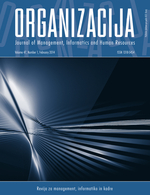Flexicurity in the European Union and Slovenia
Abstract
The purpose of this paper is to present the characteristics of labour markets in the EU Member States, with special emphasis on Slovenia, especially in terms of design and implementation of flexicurity policies. The empirical analysis points on existence of considerable differences in flexibility and security in the labour market between EU Member States. The least successful at simultaneous implementation of flexibility and security at labour market are eastern and Baltic Member States, showing rigid labour markets at very low security of employees. Even more rigid labour market have Mediterranean States (including Slovenia), however they attain higher employment security. The most balanced flexicurity policies, thus ensuring high levels of flexibility and security, can be found among Scandinavian States. The latter, together with the United Kingdom and Ireland that show the highest labour market flexibility, are characterised with the highest GDP per capita among the EU Member states, high employment rates and low rates of longterm unemployment. The Slovenian labour market is very rigid with generous social security system. In terms of flexicurity it faces many challenges, among them low flexibility of contractual arrangements, low expenditures for active employment policies and suitability of the unemployment benefits system.
Refbacks
- There are currently no refbacks.

